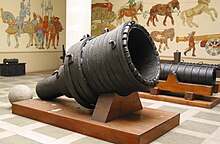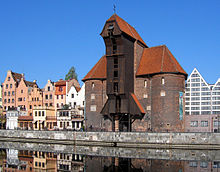
Back تقانة العصور الوسطى Arabic Средновековна технология Bulgarian মধ্যযুগীয় প্রযুক্তি Bengali/Bangla Tecnologia medieval Catalan Tecnología medieval Spanish Keskiajan tekniikka Finnish Technologie médiévale French Tehnologija srednjeg vijeka Croatian Միջնադարյան տեխնիկա Armenian Tecnologia medievale Italian


| History of technology |
|---|
Medieval technology is the technology used in medieval Europe under Christian rule. After the Renaissance of the 12th century, medieval Europe saw a radical change in the rate of new inventions, innovations in the ways of managing traditional means of production, and economic growth.[2] The period saw major technological advances, including the adoption of gunpowder, the invention of vertical windmills, spectacles, mechanical clocks, and greatly improved water mills, building techniques (Gothic architecture, medieval castles), and agriculture in general (three-field crop rotation).
The development of water mills from their ancient origins was impressive, and extended from agriculture to sawmills both for timber and stone. By the time of the Domesday Book, most large villages had turnable mills, around 6,500 in England alone.[3] Water-power was also widely used in mining for raising ore from shafts, crushing ore, and even powering bellows.
Many European technical advancements from the 12th to 14th centuries were either built on long-established techniques in medieval Europe, originating from Roman and Byzantine antecedents, or adapted from cross-cultural exchanges through trading networks with the Islamic world, China, and India. Often, the revolutionary aspect lay not in the act of invention itself, but in its technological refinement and application to political and economic power. Though gunpowder along with other weapons had been started by Chinese, it was the Europeans who developed and perfected its military potential, precipitating European expansion and eventual imperialism in the Modern Era.
Also significant in this respect were advances in maritime technology. Advances in shipbuilding included the multi-masted ships with lateen sails, the sternpost-mounted rudder and the skeleton-first hull construction. Along with new navigational techniques such as the dry compass, the Jacob's staff and the astrolabe, these allowed economic and military control of the seas adjacent to Europe and enabled the global navigational achievements of the dawning Age of Exploration.
At the turn to the Renaissance, Gutenberg's invention of mechanical printing made possible a dissemination of knowledge to a wider population, that would not only lead to a gradually more egalitarian society, but one more able to dominate other cultures, drawing from a vast reserve of knowledge and experience. The technical drawings of late-medieval artist-engineers Guido da Vigevano and Villard de Honnecourt can be viewed as forerunners of later Renaissance artist-engineers such as Taccola or Leonardo da Vinci.
- ^ Cite error: The named reference
Matheus 1996, 346was invoked but never defined (see the help page). - ^ Alfred Crosby described some of this technological revolution in his The Measure of Reality: Quantification in Western Europe, 1250-1600 and other major historians of technology have also noted it.
- ^ Holt 1988, pp. 7–8, 11
© MMXXIII Rich X Search. We shall prevail. All rights reserved. Rich X Search